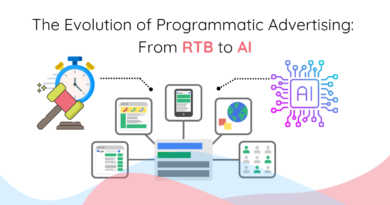Top 6 Programmatic Advertising Channels
Programmatic advertising is connecting the buyers and sellers to using the ad exchanges in a real time to trade the ad inventories. In this article, we will discuss the six commonly used programmatic advertising channels/formats.

Display Advertising: The display advertising is a broader category in online advertising. However, display ads in programmatic advertising is the ads placed at header, footer, or on the sidebars are considered as display ads.
Advertisers and publishers work with display ad networks such as Google, Microsoft, and other platforms to facilitate the trading activities. Publisher generate the revenue when ad loads on the web pages and user clicks on the ad.
Video Advertising: The fame of programmatic advertising continues to grow as video advertising continues to become one of the most of preferred channels. Digital video ad spend in the US alone is predicted to grow up to $22.18 Bn in 2021.
There are three different types of video ads;
In-Stream Video Ads: These video ads will appear in the video player. The video ads will display before video starts, in between the video or post completion of video content. There are three types of in-stream ads:
- Pre-roll: These ads appear before the video content begins to play.
- Mid-roll: Video ads will run in between the video content.
- Post-roll: Video ads will run post completion of video content.
Out Stream Ads: Out-stream video ads appear between the articles. These ads will appear either within the content or show up as pop-up windows.
In-Display Ads: These video ads will appear within the display ads and can be placed within the content or any bigger ad slots where the video cab be embedded within the ad display ads.
Social Media Advertising: Social media advertising is one of the effective programmatic advertising channel where advertiser will get an opportunity to serve the ads to the targeted audience. Social media platform collects user data and categorized based on the user preferences.
Programmatic advertising uses the user data and suggest the advertiser to serve best ad format, at idea time where the targeted audience are online and optimize the ad campaign budget to increase the ROI.
Additionally, social media ads are not exclusively restricted to platform ads. Programmatic influencer marketing automates influencer ad campaigns by identifying the targeted incluencers, onboarding them on the platform, and automating campaign management depending upon the audience and ad campaign performance.
Audio Advertising: While popular podcasts still follow the traditional sponsorship model to serve the ads, the programmatic audio advertising can amplify revenue generation efforts by serving relevant ads.
Programmatic audio platforms rely on real time audience data to serve ads and utilize engaging display ad video ads to optimize the user experience. The steaming apps serve companion ads that are often programmatic display ads, while ad pods are the audio equivalent of video ads.
The major players in programmatic audio ad serving platforms are Google, SoundCloud, Pandora, BBC, and Rubicon Project.
Native Ads: Native ads customize the look and feel of the ads by matching the web pages. In programmatic native advertising, advertisers will use the DSP to select the ad inventory where they wanted to serve the ads and publishers will sell their relevant ad slots via SSP.
According to a research conducted by IPG and Sharethrough on native ads, users looked at the native ads 53% more than display ads.
There are various types of programmatic native ads to serve on the web pages are;
- In Feed Units
- In Article Ads
- Paid Search Units
- Recommendation Widgets
- Promoted Listings
- Sponsored Content
- Rewarded Video Ads
- In-Ad (IAB Standard) with Native Element Units
Digital Out-of-Home (DOOH): Digital Out-of-Home is digitally and analytically larger evolution of traditional out-of-home advertising. The traditional DOOH sales involved advertiser getting in touch with the network and agreeing on audience targeting, pricing, screen size selection, etc., manually.
Though programmatic DOOH may appear a bit mysterious initially, it follows the same media buying process as RTB and programmatic direct.
While measurement and attribution are still challenging in programmatic DOOH due to its nativity, advertisers can run targeted and highly engaging retargeting ads.
Here’s an article to know What is Programmatic Advertising and How does it works?
Conclusion: These programmatic advertising channels are helping the advertisers and publishers effectively manage the trade of ad inventories, however, these may come up with some with advantages and disadvantages as well. The buyers and sellers needs to review the pros and cons before setting up the platforms to promote their products and services.




